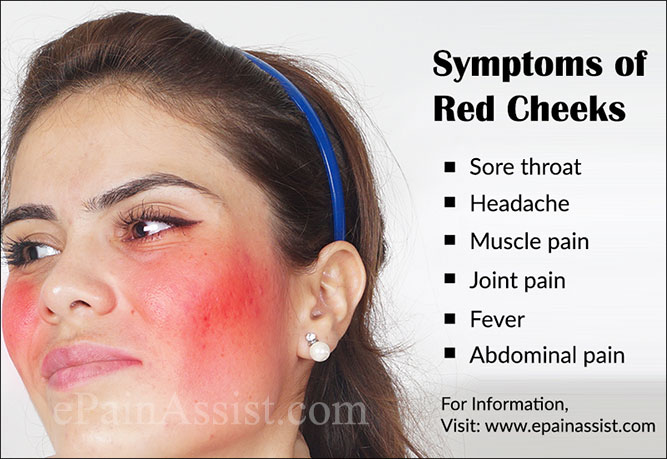What is Red Cheeks or Slapped Cheek Disease?
Red cheeks or slapped cheek disease is a medical condition occurring most commonly in children where the child looks as if he/she has been slapped due to sudden appearance of bright red cheeks. Slapped cheek disease can look similar to other childhood rashes, such as scarlet fever or rubella; however, slapped cheek syndrome commonly starts with the characteristic or distinctive appearance of bright red cheeks looking as if the child has been slapped. Slapped cheek disease commonly affects children between the ages of 6 to 10 years. This condition usually occurs in the late winter season or early spring season. Slapped cheek disease or red cheek disease rarely occurs in infants and adults. Slapped cheek disease is also known as “fifth disease” or erythema infectiosum.

Red cheeks or slapped cheek disease is an often mild condition and spreads through respiratory droplets, which contaminate the air when an infected person sneezes or coughs. Healthy children and adults usually are not at much risk for this disease; however, pregnant women who do not have immunity to slapped cheek disease are at an increased risk for having miscarriage, as this disease can cause anemia in the unborn baby.
Treatment for red cheek or slapped cheek disease is often not needed as this condition is mild and resolves within some days. Symptomatic treatment is done for symptoms, such as fever, itchiness and pain.
Causes of Red Cheeks or Slapped Cheek Disease
The cause of red cheeks or slapped cheek disease is parvovirus B19, which spreads through respiratory secretions of an infected person. At the time of appearance of the rash, the child is no longer infectious. The incubation period of slapped cheek or red cheek disease is commonly four to 14 days, but can be as lengthy as 21 days. Adults, such as teachers and childcare providers who work with young children, are at an increased risk for exposure to this disease.
Signs & Symptoms of Red Cheeks or Slapped Cheek Disease in Children
- High fever.
- Appearance of bright red cheeks.
- Appearance of a raised or flat red rash, which can be itchy, commonly on the arms and legs, which can be present from two to 40 days. The rash appears to be faded from the middle of the red areas towards the edges, which gives it a lacy appearance. There is recurrence of the rash after warm baths, exercise, emotional disturbance or rubbing of the skin.
- Less common symptoms include sore throat, headache and joint pain.
- Not every child having slapped cheek disease has a rash. Some parents can become concerned if the rash is present for many weeks or comes and goes with environmental factors, such as warm baths and exercise, which happens to be a normal scenario.
Signs & Symptoms of Red Cheeks or Slapped Cheek Disease in Adults
Given below are the symptoms of red cheeks or slapped cheek disease which occur more frequently and are more severe in adults suffering from parvovirus B19 infections. These symptoms usually precede the rash, which often does not appear by a week to 10 days. The symptoms in adults are:
- Sore throat.
- Headache.
- Muscle pain.
- Joint pain.
- Fever.
- Abdominal pain.

Many fetuses are not affected when the mother contracts the virus and there is no proof that this disease can cause birth defects. However, if the fetus becomes infected, then the virus can hinder the fetus’s ability to produce RBCs (red blood cells). This leads to a dangerous type of anemia, heart failure, and can also result in a miscarriage or stillbirth.
When to Seek Medical Advice for Red Cheeks or Slapped Cheek Disease?
- If the child has an impaired immune system.
- If the child has sickle cell anemia or has any other chronic anemia.
- If the child has been exposed to red cheek or slapped cheek disease and is having symptoms of this disease.
- If the mother is pregnant and does not known her immunity status to parvovirus B19; or, if the mother has come in contact with anyone who is suffering from infection of parvovirus B19.
- If the infected child feels and looks very ill.
- If the rash becomes painful, purple or blistered or is present for more than five weeks.
Treatment for Red Cheeks or Slapped Cheek Disease
Treatment is often not required as red cheek or slapped cheek disease is usually a very mild condition, which resolves in a few days. Sometimes slapped cheek disease can last for up to four to five weeks.
- There are no specific antiviral medications available for red cheek or slapped cheek disease.
- Symptomatic treatment is done for high temperature, headaches or itchy skin with over-the-counter medications, such as antihistamines, paracetamol and ibuprofen. These medications help in relieving symptoms of red cheeks or slapped cheek disease like headache, high temperature and joint pain. Aspirin should not be taken by children who are under 16 years of age.
- Antihistamines for red cheeks or slapped cheek disease disease help in relieving itchy skin. There are some antihistamines, which are not suitable for children who are below two years of age. So consult your doctor before giving them.
- Emollients, such as moisturizers, help in soothing the itchy skin.
- Rest and plenty of fluids are important for the child suffering from slapped cheek disease or red cheek disease. These will help in relieving the symptoms of high temperature and sore throat.
- NSAIDs, such as ibuprofen, can be given to adults who develop joint pain for relief.
- Centers for Disease Control and Prevention (CDC) – Parvovirus B19 and Fifth Disease: https://www.cdc.gov/parvovirusb19/fifth-disease.html
- National Health Service (NHS) – Slapped Cheek Syndrome (Fifth Disease): https://www.nhs.uk/conditions/slapped-cheek-syndrome/
